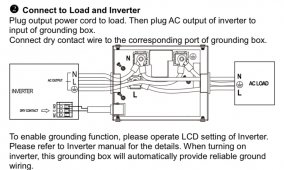I own an MPP Solar PIP 2424LV-MSD that is completely off grid and have been troubleshooting this same flickering / voltage variance. Like
@iamrich states, the issue comes in when there is low load on my system. The specific trigger is going from 300 watts of load or more down to 95 - 150 watts of load. When this happens suddenly (turn off the light switch, the AC shuts off, etc.) the inverter goes wonky and starts ranging the output voltage from ~105v to 130v ... sometimes (70% yes / 30% no). When this is happening, the problem goes away once a heavy load is put back on.
I have done several tests to find the above trigger and feel confident in what I have found. I can repeat the trigger / issue with ~70% success rate of triggering it on the first try.
I have @150 watts of overhead LED lights and a window A/C unit (~350 - 500 watts while running) along with a 12 cu ft upright freezer (~98 watts continuous) and a 7cu ft chest freezer (~55 watts continuous) all on the same 20 amp circuit. With all of these powered up and running, everything is super stable.
If the A/C AND the overhead lights are both running, you can shut off either on and the problem will never happen. If you are only running one or the other and the freezers, about 70% of the time when the lights or A/C turn off, the inverter cannot properly adjust from the higher load to the lower load and goes into the voltage ranging issue. The only way to get back out of it is to either turn everything off and do a complete cold start, or to add a significant load back onto the inverter and it will then drive up to the new load and stabilize. I have taken the freezers out of the mix and put a 100 watt incandescent bulb in their place and have successfully repeated the trigger with both shutting off the AC (no overhead lights) and shutting off the overhead lights (no AC running) and the 100 watt incandescent bulb will flicker and the voltage output on the solar charge controller shows output voltage ranging from 105v to 130v rapidly.
This is where I am at with discovery. Just now starting to research online and found this thread first. Also see several other threads related to this topic. So, I'm clearly not the only one seeing this issue and MPP Solar is not the only manufacturer with this issue.
Again, this system is completely off-grid and is not fed by nor tied to any utility power. Full system details below.
Solar Panels: 6 Rich Solar 200w panels - 2 banks of 3 for a total VOC of 135v (just at the max for the 2424LV and sometimes over the max if I am not drawing power from the panels and have to do a cold start in full sunshine.
Two 8s 24v 120AH LiFePO4 battery banks with OverKill Solar BMS units. These packs are in parallel and
MPP Solar PIP 2424LV-MSD - above solar panels coming into PV in, the 2 battery banks are paralleled and coming into the battery connectors.
The output from the solar charge controller is going to a small breaker box with 2 circuits in it. One circuit feeds the A/C and the other feeds everything else. (So, the A/C and the lights are on different "circuits" if you will - but not really).




